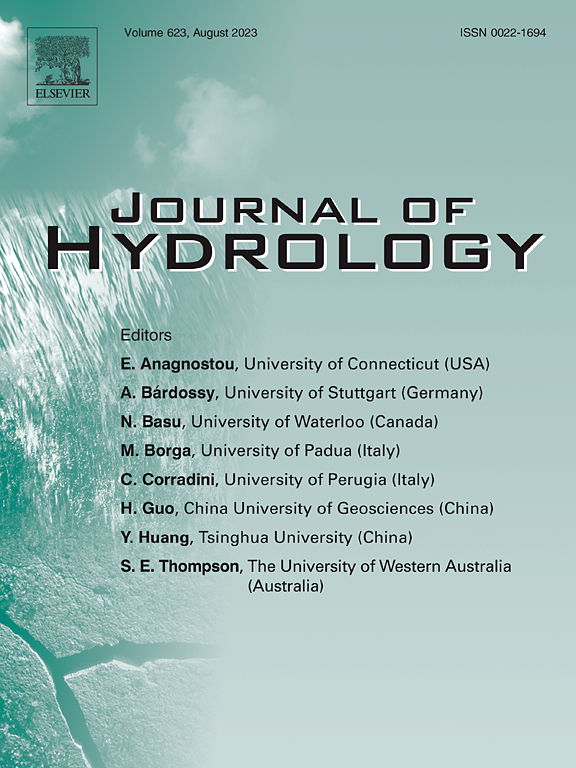Coupling dynamics of soil moisture-nitrate in deep profiles and their relations to groundwater nitrate pollution in irrigated apple production systems
IF 6.3
1区 地球科学
Q1 ENGINEERING, CIVIL
引用次数: 0
Abstract
Heavily fertilized and irrigated apple orchards on China’s Loess Plateau may contribute to regional groundwater nitrate pollution. To examine the groundwater pollution risk, we analysed moisture and nitrate in deep soil profiles in cropland and different aged apple orchards and nitrate in groundwater in conventionally and excessively irrigated orchards. Compared with cropland, conventionally irrigated apple orchards had higher moisture at 0–6 m but also a desiccation layer at 6.4–11 m. Regression analysis predicted desiccation would first appear at 14-yr apple orchards. Excessive irrigation did not eliminate the desiccation layer, and its thickness increased with stand age. Residual soil nitrate was significantly higher in orchards than in croplands. Soil NO3−-N content stabilized at increasing depth with increasing stand age. Low NO3−-N concentrations at depth and dual isotope comparisons of δ15N-NO3− and δ18O-NO3− indicated that 13 m was a sufficient depth to evaluate soil NO3−-N in irrigated apple orchards. Groundwater NO3−-N was much lowers in conventionally than in excessively irrigated apple orchards. According to a MixSIAR isotope mixing model, synthetic N fertilizer was the greatest contributor to groundwater NO3−-N. Soil NO3−-N was predicted to pollute groundwater at 38 years. Thus, fertilization and irrigation must be optimized to eliminate soil desiccation, reduce nitrate surplus, and protect groundwater.

灌溉苹果生产系统深层土壤水分-硝酸盐耦合动态及其与地下水硝酸盐污染的关系
黄土高原苹果园重度施肥和灌溉可能导致区域地下水硝酸盐污染。为了检验地下水污染风险,我们分析了农田和不同年龄苹果园深层土壤剖面的水分和硝酸盐,以及常规灌溉和过度灌溉苹果园的地下水硝酸盐。与农田相比,常规灌溉苹果园0 ~ 6 m含水率较高,但6.4 ~ 11 m有干旱层。回归分析预测,干燥将首先出现在14年苹果园。过量灌溉不能消除干旱层,且干旱层厚度随林龄增加而增加。果园土壤硝态氮残留量显著高于农田。随着林龄的增加,土壤NO3−-N含量随深度的增加而趋于稳定。深层NO3−-N浓度较低,δ15N-NO3−和δ18O-NO3−双同位素比较表明,13 m是灌溉苹果园土壤NO3−-N评价的足够深度。常规灌溉苹果园地下水NO3−-N显著低于过量灌溉苹果园。MixSIAR同位素混合模型表明,合成氮肥对地下水NO3−-N的贡献最大。预测土壤NO3−-N对地下水的污染时间为38 a。因此,施肥和灌溉必须优化,以消除土壤干燥,减少硝酸盐过剩,保护地下水。
本文章由计算机程序翻译,如有差异,请以英文原文为准。
求助全文
约1分钟内获得全文
求助全文
来源期刊

Journal of Hydrology
地学-地球科学综合
CiteScore
11.00
自引率
12.50%
发文量
1309
审稿时长
7.5 months
期刊介绍:
The Journal of Hydrology publishes original research papers and comprehensive reviews in all the subfields of the hydrological sciences including water based management and policy issues that impact on economics and society. These comprise, but are not limited to the physical, chemical, biogeochemical, stochastic and systems aspects of surface and groundwater hydrology, hydrometeorology and hydrogeology. Relevant topics incorporating the insights and methodologies of disciplines such as climatology, water resource systems, hydraulics, agrohydrology, geomorphology, soil science, instrumentation and remote sensing, civil and environmental engineering are included. Social science perspectives on hydrological problems such as resource and ecological economics, environmental sociology, psychology and behavioural science, management and policy analysis are also invited. Multi-and interdisciplinary analyses of hydrological problems are within scope. The science published in the Journal of Hydrology is relevant to catchment scales rather than exclusively to a local scale or site.
 求助内容:
求助内容: 应助结果提醒方式:
应助结果提醒方式:


